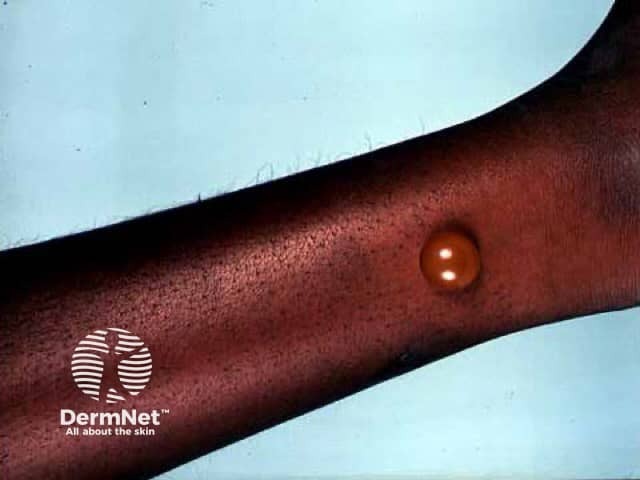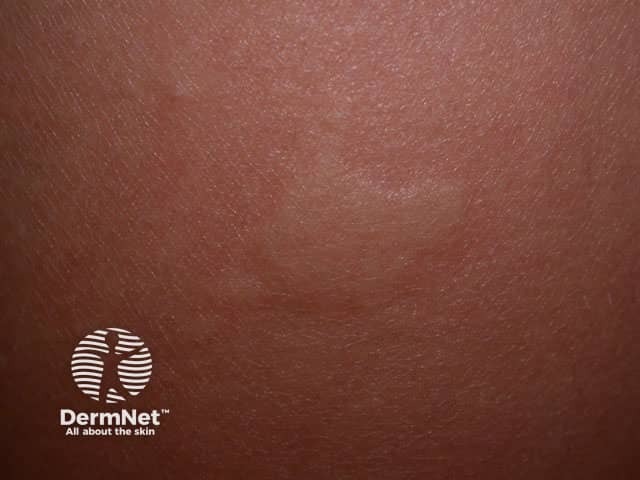Main menu
Common skin conditions

NEWS
Join DermNet PRO
Read more
Quick links
Author: Vanessa Ngan, Staff Writer, 2003. Updated by Hon A/Prof Amanda Oakley, Dermatologist, Hamilton, New Zealand, October 2015.
Introduction Causes Demographics Clinical features Complications Diagnosis Treatment Prevention
Arthropods include insects, spiders (arachnids), mites and ticks.



Insect bites and stings can be divided into two groups: venomous and non-venomous. A small number of spiders are also venomous.
A sting is usually an attack by a venomous insect that injects toxic and painful venom through its stinger as a defence mechanism. Venomous insects include:
Venomous spider bites are rare but have potentially serious systemic neurotoxicity (eg, Lactrodectus species), or usually local, cytotoxic effects (eg, Loxosceles species). The majority of household spiders are harmless. Identification of the offending spider is essential to determine management including antivenin.
Non-venomous insects pierce the skin to feed on blood. This usually results in intense itching. Non-venomous insects that bite include:
Some caterpillars and moths have irritating hairs and sharp spines, causing stinging, short-lasting papular urticaria, dermatitis and allergic reactions.
Anyone exposed to arthropods can be bitten or stung. Arthropod habitats are variable and individual risks depend largely on geographic and climatic factors. Time of day may be important. For example, some mosquitoes bite at night and others during daytime. Other factors to consider include:
Mosquitoes are attracted to body heat, carbon dioxide in exhaled air, human sweat, and human microflora.
The reaction to encounter with an arthropod depends on the species involved, whether it carries disease, and individual factors such as host immunity.
A venomous sting from a bee or wasp usually causes a stinging sensation or pain with redness and swelling of the area. Sensitisation to the venom affects response.
An insect bite presents as one or more intensely itchy papules on a body site exposed to the insect.


Bullous insect bite

Immediate urticarial reaction
More images of insect bites ...
Complications of arthropod bites include:
Papular urticaria is a hypersensitivity reaction, most often in a young child due to fleabites and/or mosquito bites. New bites are accompanied by reactivation of old ones and present as symmetrical crops of itchy urticated papules. Papular urticaria resolves with the development of immunological tolerance.
Solitary persistent insect bite reactions can be urticarial, bullous, vasculitic or granulomatous.
Diseases in which specific arthropods are the vector occur worldwide but are particularly prevalent in tropical and developing regions.
They include:
Generally people are aware of bites, especially if they have observed the arthropod, but occasionally they are not. The clinical appearance is usually typical.
Skin biopsy can be suggestive if it shows central punctum, eosinophilic spongiosis, and a wedge-shaped mixed dermal infiltrate distributed around the sweat ducts/glands.
If the reaction is mild, insect stings should be treated by first removing the stinger. This is necessary as the stinger continues to pump venom from its sack until it is empty or removed.
If an insect sting causes a severe reaction or anaphylaxis, urgent medical attention should be sought. If a patient is known to have an allergy to insect stings they may carry with them an allergy kit containing adrenaline (epinephrine).
The main treatment aim of insect bites is to prevent itching.
Bites from insects carrying disease require specific antimicrobial therapy to treat the disease.
The following simple measures can prevent arthropod stings and bites: